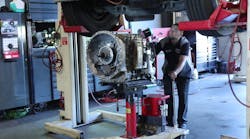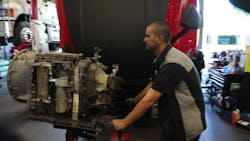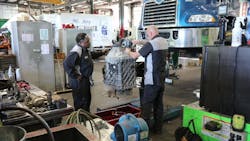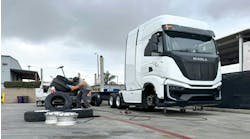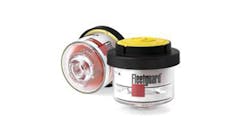Automated manual transmissions, or AMTs, have been successfully adopted into the heavy-duty commercial vehicle space for numerous reasons, but if you want to keep it as simple as using one, it would be for the sake of consistency.
“The top 5 to 10% of manual drivers versus AMT might not improve drastically with an AMT, but the bottom 90-95% certainly will,” said Johan Agebrand, director of product marketing, Volvo Trucks North America.
As of 2020, AMTs were spec’d in at least 90% of Class 8 flagship trucks from OEMs including Freightliner, International, Mack Trucks, Peterbilt, Volvo Trucks. Kenworth’s T680 AMT adoption reached 86% this year, growing from 30% in 2013.
With the widespread adoption of this equipment in the industry today, most, if not all, technicians have dealt with AMTs; proficiencies have been unveiled in vehicle performance as well as service intervals and maintenance practices. Understanding the best practices in servicing, including how to leverage diagnostics and an adherence to lubrication intervals, will ensure a fleet gets the most out of their AMTs.
Why AMTs?
“The biggest difference between AMTs and manuals is that with AMTs, more features and functions can be provided by the truck OEM in areas such as response, performance, and fuel efficiency,” Agebrand said.
And many drivers, especially longtime ones whose bodies felt each and every gear change, have been relieved.
“The driver shortage was certainly a primary factor; fleets needed trucks that were easier to drive,” said Mark Saholsky, director of product management at Eaton Cummins Automated Transmissions, of AMTs’ acceptance into the market.
“AMTs can replicate the shifting of the most efficient driver, allowing fleets to save fuel right away with a less experienced driver,” said Jason Johnson, director of vehicle integration, Paccar Technical Center. “This also reduces wear and tear on the vehicle because shifting is done smoothly and consistently.”
For better driver satisfaction and efficiency, OEMs have added features such as hill start aid, engine overspeed protection, and predictive shifting, Saholsky explained.Along with easing a driver’s job, the rise of AMTs allowed for a more perfect union between the engine and transmission. “The need for the engine and transmission to work better and smarter together—powertrain integration—was also key,” Saholsky continued. “This enabled improved fuel economy and better safety features for drivers and those around the truck.”
One such benefit was engine downspeeding, or the speeding up of the rear gear ratio to lower the engine speed. This alone could create a 3% reduction in a truck’s fuel cost, according to the North American Council for Freight Efficiency.
With the overwhelming benefits, AMTs took over.
“Once truck manufacturers were able to show how AMTs improved the truck and driving experience, fleets just needed to do their payback analysis in order to justify the increased price of the truck,” Saholsky said.
Of course, AMTs continue to further develop.
“AMTs are mature products, so improvements in performance and comfort are mainly handled through software algorithms and electrical diagnostic features,” Agebrand said. “When it comes to developments on AMTs, there is still a demand for faster shifts that cannot physically be done by a driver. Today, we are almost at a speed where AMTs actually perform ‘close enough’ to an automated transmission level with power delivery that there are very few applications left where an automated transmission, from a technical perspective, is needed.”
And the improvements are ramping up.
“We’re really excited about the upcoming Endurant XD series,” Saholsky said. “They are purpose-built, high-performance 18-speed automated transmissions that combine the efficiency, light weight, and low total-cost-of-ownership DNA of the Endurant platform and the reliability and toughness of the 13- and 18- speed manual transmissions that are popular in trucks of all types and a wide variety of applications. They have high-capacity bottom 8-bolt and rear PTO openings standard.”
These design changes are set to further improve fuel economy, performance, and extend service intervals, adding to a better TCO, Saholsky added.
Best practices for service
Though AMTs offer numerous advantages for a fleet’s operation, those advantages are not fully realized without attentive and adequate maintenance. It starts with technician training.
“I think the biggest thing is making sure they are educated on the product,” said Jason Lucero, service director for the Western region at TranSource, which maintains Mack, Volvo, Hino, and Isuzu trucks. “I think there were some people that were late to get into the game on the training for [AMTs], because people didn’t expect them to take off. Whereas the majority of our trucks that we sell now have automated manual transmissions. But the biggest thing, above and beyond anything, is the understanding of the product itself; and the training certainly is the most important.”
Lucero explained that TranSource leverages OEM web-based training for initial certifications for their technicians, followed by instructor-led training for component-specific certifications. TranSource also has a certified technical trainer within the organization that teaches courses on-site at their training facility where technicians attend two- to three-day classes featuring hands-on training.
“When it comes to best practices and servicing, you should follow the truck OEM’s maintenance intervals and instructions, as well as using the correct tools and original parts,” Agebrand recommended.
The smooth operation of an AMT on the road lends to their extended service intervals.
“The maintenance intervals are a lot more efficient now with this equipment,” Lucero pointed out. “For the Mack and Volvo side of things, there are 500,000 miles between service intervals. Right off the bat, you’re at half a million miles before you even service one of these, which is incredible when it comes down to cost of ownership.”
The extended service intervals can, in part, be attributed to the automated aspects of the system.
“As far as the maintenance side of it, we’ve actually seen a huge decrease in failure,” Lucero said. “Now, that’s a little bit convoluted, because there were some bugs to work out in the first couple years.” After that initial learning curve, he said AMTs typically run longer before failure than manuals.
“You’re taking the human error out of it,” Lucero continued. “These trucks have changed so much with downspeeding technology. And the transmission plays such an integral role in that.”
And downspeeding benefits overall fleet TCO by allowing the engine to burn fuel more efficiently at lower RPMs, Lucero explained.
Staying ahead of system issues through preventive maintenance is always a best practice, and AMTs are no exception, though vehicle software lends its hand in accurately understanding the system’s health.
“Preventive maintenance is very similar [in comparison to manual transmissions] in that you need to inspect things like the clutch,” Agebrand stated. “However, the way you do this is very different between AMTs and manual transmissions. On manual transmissions, you have to actually de-couple the transmission from the engine and visually inspect. For AMTs, the vehicle and software do this and can alert the service technician through the OEM service tool on the status of the clutch.”
Should PMs be missed, or proper vehicle operation is not upheld, expect clutch issues.
“One of the main issues fleets can expect from not properly maintaining or operating the vehicle is that the clutch will break through by wearing down.” Agebrand continued, stating this is intentional in the system’s design. “Otherwise, the actual gearing shafts and gears inside the transmission will break. This is the same for both AMTs and manuals.”
If the truck is in the bay, it is always useful to conduct a visual inspection.
“We’re looking for things like leaks,” Lucero said of TranSource’s inspection routine. “We’re looking at U-joints and drive lines for any kind of wear and tear that is going to add additional stress to that transmission. We’re going to look at the output shaft and make sure that we don’t see any seepage there—that we don’t have unnecessary movement and play up and down.”
He also said they inspect airlines to ensure good routing and that no kinking is present, nor that there is any presence of moisture.
“These automated transmissions are constantly starving for air pressure—you have to have a good air system on that truck to operate at its optimal performance,” Lucero explained. “We’re also looking for any kind of fatigue on fittings, looking to make sure linkages are properly attached and not binding and are lubricated properly.”
Beyond the AMT itself, fleets will need to ensure that the electrical and air systems are up-and-running as spec’d.
“Whether electrically shifted or pneumatically shifted, data links have an important role in AMT operation,” Saholsky stated. “When not functioning properly, data links can cause undesirable vehicle launches and shifting issues after launch. Many new vehicles have an extremely high bus load on the data link, which can cause error messages if any of the electronic control units are improperly functioning or if the physical wiring of the data link has been compromised.”
Saholsky said that because newer vehicles in recent years have incorporated two different Baud Rate data links—250,000 and 500,000—previous issues surrounding this aspect of the system have been reduced.
Battery maintenance is crucial for electrically shifted AMTs, Saholsky reminded. Beyond monitoring and maintaining the battery itself, fleets should monitor the electrical system on a regular basis—staying mindful of warning signs like corrosion, wire chafing, and loose connections—which will affect AMT performance.
It is most likely that a shop is already equipped and tooled to handle AMT servicing. Though, there are considerations to keep in mind that may ease services and boost productivity.
“In general, there are no specific tools or equipment needed given that the basic design is the same as manual, with the addition of a virtual driver in the software for the transmission electronics,” Agebrand said. “Unique tools may exist on electronics and diagnostics depending on the OEM, but because electrification of certain components is occurring across the whole truck, there is really no difference between manual and AMTs in this sense.”
“There are different types of equipment that make life easier,” Lucero offered. “In a lot of our facilities, we have the luxury of having full truck lifts. We can lift the truck in the air to be able to drain fluids or pull the transmissions out if we need to.”
Diagnostics
It comes as no surprise that diagnostic software can help pinpoint AMT issues; but fleets should be aware of the different avenues of diagnostic services available to help maintain these systems.
TranSource leverages Mack GuardDog Connect to stay on top of Mack mDrive diagnostics.
“It’ll give us a lot of information… It goes through the Uptime Center, which will route that truck and that information to the closest dealer… Mack GuardDog Connect has a lot of value to it,” Lucero claimed. “It’s constantly scanning that truck, and then if there’s over-the-air programming that can improve [vehicle performance], then it’ll try to do that first, of course, but it monitors everything on that truck and tries to optimize the uptime of that vehicle.”Lucero explained that this information helps users make the most informed decision of when and where to service a vehicle, maximizing ever-valuable uptime.
Volvo’s Agebrand attested to iShift’s remote diagnostic capacity.
“The complete powertrain has full remote diagnostics and telematics support in a Volvo truck,” he said. “It is an ‘iPhone on wheels,’ and these kind of features and services will continue to develop for future products.”
TranSource also uses ASIST/Fleet from Decisiv as part of their diagnostic maintenance program. Lucero said that the specifically AMT-related things to look for when scanning a vehicle includes any active codes such as a shift denied, a neutral issue, or codes related to shift patterns.
“What we have found, though, is we don’t generally see fault codes that are active like that when they’re coming in for preventive maintenance on the automated transmissions,” he said.
Lucero said generally the reason the truck was brought in, either by tow or under its own power, was because the system “has given them a symptom, whether it’s stuck in neutral, or it won’t shift, or it’s sluggish, or not pulling properly.”
When it comes to Eaton transmissions, Saholsky explained the in-shop and remote diagnostic capabilities available through ServiceRanger 4 and IntelliConnect, respectively.
“An AMT is a more technologically complex transmission,” Saholsky related. “Up-to-date diagnostic software is essential. Eaton’s PC-based diagnostic software is called ServiceRanger 4. Every AMT has a fault code hierarchy which helps technicians quickly identify the faults that are most important. For instance, if a technician sees a range of high and low fault numbers, the technician can address the lower fault code number before moving up to the next highest number.”
Having a diagnostic system provide a plan of attack when servicing a vehicle in bay is advantageous; it is also helpful to have a diagnostic approach before the vehicle reaches a shop.
“With an AMT, a computer is essentially deciding when to shift gears and perform clutch actuations,” Saholsky said. “If the transmission system fails to perform as expected in the field, the ability to connect, diagnose, and repair from a remote location can help get the vehicle back up and running much faster. Eaton’s remote diagnostics tool, IntelliConnect, helps monitor system performance, recognize fault codes, and initiate fault code action plans so fleets can better avoid catastrophic failures and costly downtime.
“IntelliConnect remote diagnostics technology is a suite of connected solutions designed to improve a fleet’s uptime and efficiency and reduce the total cost of ownership,” Saholsky continued. “IntelliConnect provides near real-time monitoring of vehicle fault codes, prioritizes the critical events, and provides accurate and comprehensive action plans created by Eaton’s technical experts. These features can help increase fleet uptime by reducing unplanned downtime and providing quicker repair diagnosis.”
Among IntelliConnect’s newest feature set is the ability for users to monitor all vehicles associated with their fleet or view specific vehicles selected for a “Watch List” based on make or model, engine make, and even transmission model, Saholsky explained. IntelliConnect is included with every Eaton Cummins automated transmission.
Lubrication
To keep things running smoothly, AMTs must adhere to their recommended lubrication intervals. Lubrication intervals are typically the same for AMTs and manual transmissions, Saholsky said.
“However, there are lubricants specifically formulated for AMTs,” he continued. “For example, Eaton’s heavy-duty AMTs require Eaton’s PS-386 transmission lube, which is specially formulated to prevent wear and improve fuel economy. Fleets should always refer to manufacturer recommendations as to which lubes should be used in which transmissions, especially with AMTs.”
Lubrication of automatic transmissions has also seen some recent improvements. Chevron recently released Delo Syn ATF 668 transmission fluid. Penney Do, product technology specialist at Chevron, said, “Chevron worked closely with Allison Transmission to develop fluids that are optimized for the majority of their transmissions. Delo Syn ATF 668 is one of those fluids that, compared to Allison TES-295 fluids, offers better friction performance resulting in longer equipment life, lower equipment maintenance cost, and less complex fleet maintenance. Additionally, the lower cost of this product (compared to Allison TES-295 fluids) at each drain means reduced total life of equipment costs, which was another driver for this product introduction by Chevron.”
Delo Syn ATF 668 is a full synthetic fluid designed to provide excellent anti-shudder durability and clutch performance for smooth and steady operation of all the Allison transmissions requiring TES 295, 389, 468, and TES 668, over wide temperature ranges, Do related.
Jason Gerig, Chevron Americas commercial on and off highway sector manager, stated, “With Delo Syn ATF 668, we are enabling work truck and bus operators to decrease maintenance needs and increase the amount of time a vehicle can remain in operation.”
“Protecting the components and overall transmission over extended drain intervals increases the time that vehicles remain in operation, their quality of use is improved, and those vehicles need less complex oil monitoring and potential repair at each drain interval,” Do reinforced. “All these decrease the maintenance cost of fleet maintenance while reducing the costly downtime of fleets.”
Do related that conducting fluid changes at specified intervals, while maintaining detailed records, is prudent, particularly when the parts are still under warranty. Also, proper storage and labeling systems of fluids will ensure fluid quality and mitigate fluid mix-ups.
Citgo’s SynDurance 668 ATF is a full synthetic transmission fluid with low viscosity, said Steve Bowles, senior product specialist at Citgo.
“It’s full synthetic and is backwards compatible with the older spec, TES 295,” Bowles said. “If you’ve been using the 295 for older equipment, this will work perfectly with that, and it is also recommended for the newer equipment.”
Bowles related that SynDurance 668 ATF will improve upon corrosion resistance and wear protection, protecting parts longer, even though it is a lighter viscosity than the older fluids.
“You don’t lose any protection with the light viscosity,” he said. “That’s what a lot of people fear is [that with] low viscosity, you’re going to start seeing wear, but you won’t see that with this new fluid.” Bowles continued, saying that lower viscosity can lead to better service intervals and fuel efficiency. However, he warned what technicians and drivers may face if they do not adhere to recommended service intervals.
“The oil can oxidize, it can thicken up, and you’ll lose some fuel efficiency,” he said. “You may notice some shift difficulties or rougher shifts. You can hear some grinding sometimes.”
